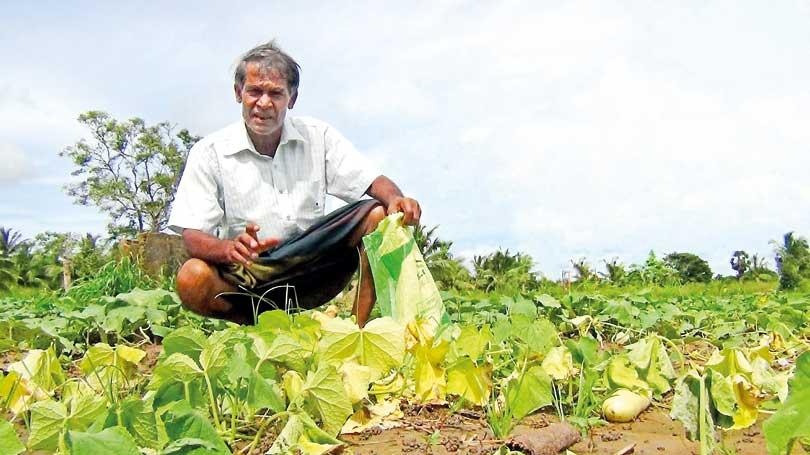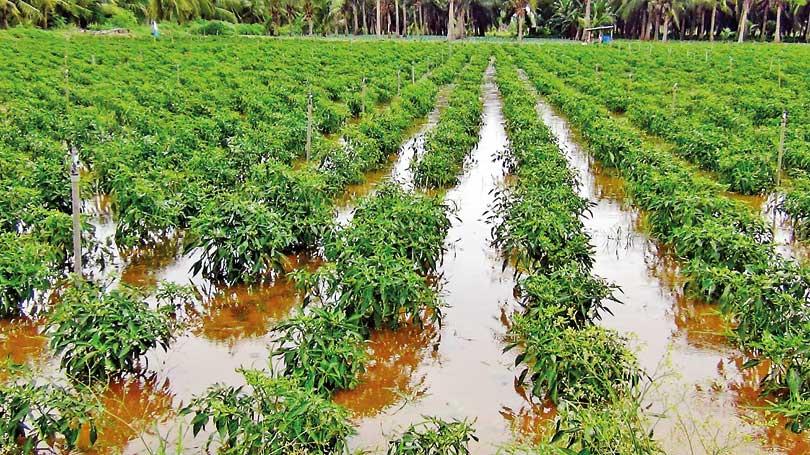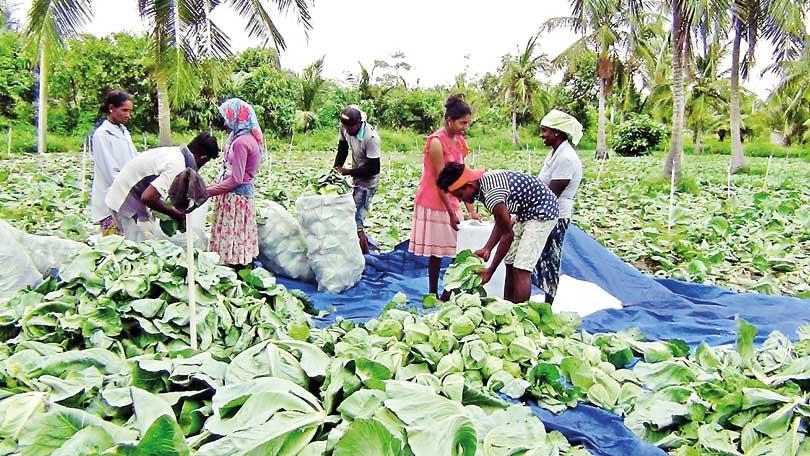Reply To:
Name - Reply Comment

 Sri Lanka is reeling from the downpour across the island, with hundreds of people across ten districts affected by flash floods, heavy rainfall and strong winds. While in the capital, commuters were seen grappling with flooded roads, which disrupted traffic flow across the city last week, at least five weather-related fatalities were reported earlier this month from various parts of the island. According to the Disaster Management Centre (DMC), a total of 6318 people have been affected by the adverse weather conditions experienced over the past few weeks. As many as 160 cases of property damage were also reported, with the highest number of cases being reported from Puttalam, Gampaha and Jaffna districts.
Sri Lanka is reeling from the downpour across the island, with hundreds of people across ten districts affected by flash floods, heavy rainfall and strong winds. While in the capital, commuters were seen grappling with flooded roads, which disrupted traffic flow across the city last week, at least five weather-related fatalities were reported earlier this month from various parts of the island. According to the Disaster Management Centre (DMC), a total of 6318 people have been affected by the adverse weather conditions experienced over the past few weeks. As many as 160 cases of property damage were also reported, with the highest number of cases being reported from Puttalam, Gampaha and Jaffna districts.
The DMC officials in Puttalam confirmed that 31,720 persons were affected by the floods and heavy rains in the district. 1,725 families have been relocated to 19 safe locations until floods recede.
This is a situation that Sri Lanka is becoming increasingly familiar with. Yet, no course of action to tackle the growing need of building a climate-resilient country seems to materialise.
According to a recent report published by the Asian Development Bank Sri Lanka spends USD 19 million every year directly on health-care costs associated with floods and droughts.
The study found that this cost is divided almost equally between the public and households, with 83% of it spent on flood-related health care and the rest on drought-related health care. While flooding undoubtedly poses a grave health risk, agricultural communities face perhaps the greatest threat of all, the loss of their crops.
At least five weather-related fatalities were reported earlier this month from various parts of the island. According to the Disaster Management Centre (DMC), a total of 6318 people have been affected by the adverse weather conditions experienced over the past few weeks.
For many agrarian communities of Sri Lanka, rains from the South West Monsoon, lasting from May to September,and the Second Inter-Monsoon from October to November are integral for the cultivation of the Maha season, which is responsible for the bulk of the country’s paddy production. Ironically, however, these rains have also been the cause of the destruction of these crops.
In Kalpitiya, farmers have suffered losses of millions of rupees due to the flash floods in the area.

W.N.M. Fernando, a farmer from the area said that his two-acre plot of land was ready to be harvested when the heavy rains lashed out leaving his field waterlogged.
“We were about to reap the harvest when it started raining. I was expecting an income of around Rs. 1.5 million out of this harvest. But now, after the floods, these crops would only earn about Rs. 200,000. I have spent about Rs. 400,000 for sowing alone and I cannot even imagine of covering the costs,” he calculated.
According to Fernando, in Kalpitiya, cabbage can only be planted during this time of the year, where the cold climate towards the end of the year is favourable for the growth of the crop. Similarly, many other farmers of the area grow various vegetables including onion, ribbed gourd and cucumber across some 150 acres of plantations.
Since the Monsoon rain began in August, the farmers of the area who rely on the income from multiple crops grown over the year, have been facing numerous weather-related challenges.
In August the farmers who were in the midst of drying Ceylon tobacco were greeted with intermittent showers throughout the month.
“There was no sunlight for the tobacco leaves to dry. We couldn’t sell them as we hoped to. We have never experienced rain like this during this time of the year” Fernando lamented.

Farmers have suffered lossess in millions of rupees due to incessant rains
Asked if the farmers of the area were offered help by the authorities in managing their crops, the farmer said that no government official has visited the plantation sites, even after several days of floods.
“The heavy rains continue and no government official has visited these plantations to inquire of our situation, so far,” he said.
“The agricultural department officials are not familiar with the techniques and methods which are suitable for this terrain,” he said, adding that officials seem to be unaware of the best practices for sustaining crops in Kalpitiya.
We were about to reap the harvest when it started raining. I was expecting an income of around Rs. 1.5 million out of this harvest. But now, after the floods, these crops would only earn about Rs. 200,000. I have spent about Rs. 400,000 for sowing alone and I cannot even imagine of covering the costs
W.N.M. Fernando
“They often attempt to introduce farming techniques which are suitable for the farmers in Dambulla and other areas of the country, but not Kalpitiya. We are farmers by tradition and we employ traditional methods and techniques to sow and reap our harvests, we can’t rely on the agricultural department for help, as I don’t think they have enough knowledge on the farming practices of this area.” he opined.
The Department of Meteorology issued a weather forecast of continued showers for the Eastern, Uva and Southern Provinces as well as the Puttalam District. Over the last few weeks, water levels at three monitoring stations on the Kelani River exceeded the alert level, but have now receded to normal levels.
While water levels of Nilwala, Kalu and Attanagalla rivers returned to normalcy, the sluice gates of the reservoirs Deduru Oya, Thabbowa, Rajanganaya, Angamuwa and Polgolla remain open, causing concern for many residents along low-lying areas.

However, residents along the Southern coast witnessed rising sea waves reach Galle Road on Monday, from the Kahawa area to the Telwatta Junction. According to authorities, several areas along the Galle Road were inundated with seawater, a phenomenon referred to as coastal flooding.
According to sources at the National Aquatic Resources Research and Development Agency (NARA) wave heights are susceptible to change during the South West Monsoon.
“The average wave height would be two metres, whereas the waves that occur during this monsoon are more than three metres in height,” R.M.R.M Jayathilake of the National Institute of Oceanography and Marine Sciences explained.
According to officials at NARA, significant changes have been observed in the wave climate over recent years. These are usually identified as extreme waves which cause coastal inundation. Extreme wave heights, not only cause coastal flooding, as recently witnessed in the Telwatte and Kahawa areas in the Southern coast but also causes significant coastal erosion.
When analysing data since the 1980s officials have noted that there exists a change in the wave climate. The wave climate is the distribution of wave characteristics averaged over a period of time and for a particular location.
According to officials at NARA, significant changes have been observed in the wave climate over recent years. These are usually identified as extreme waves which cause coastal inundation. Extreme wave heights, not only cause coastal flooding, as recently witnessed in the Telwatte and Kahawa areas in the Southern coast but also causes significant coastal erosion.
Officials noted that these changes are usually attributed to climate change and global warming. They added that in order to mitigate the adverse effects there are soft and hard measures which can be implemented to prevent further damage.
“One soft measure is called sand nourishment or beach replenishment,” the official described the process by which sediment, usually sand, lost through longshore drift or erosion is replaced from other sources.

In Kalpitiya, over 8,000 families have been affected by the heavy rainfall and floods
He noted that beach nourishment is typically part of a larger coastal defence scheme. “Sand nourishment is typically a repetitive process, it does not remove the physical forces that cause erosion but simply mitigates their effects.
As many as 160 cases of property damage were also reported, with the highest number of cases being reported from Puttalam, Gampaha and Jaffna districts.
A hard measure to prevent damage from extreme waves is to install sea-dykes. A sea dyke is a manmade structure designed to protect low-lying areas from flooding from the sea.
They typically are designed with several components including a sand core, a watertight outer protective layer and a drainage channel.
In the Netherlands, where any major fluctuation in sea levels cause extensive inland flooding, an assortment of remedies such as sea dykes, windmill pumps along with vast dams were implemented to keep the sea at bay.
NARA officials noted that such major interventions both locally and globally are required to keep the adverse effects of changing weather patterns, low.

Pix by Hiran Jayasinghe